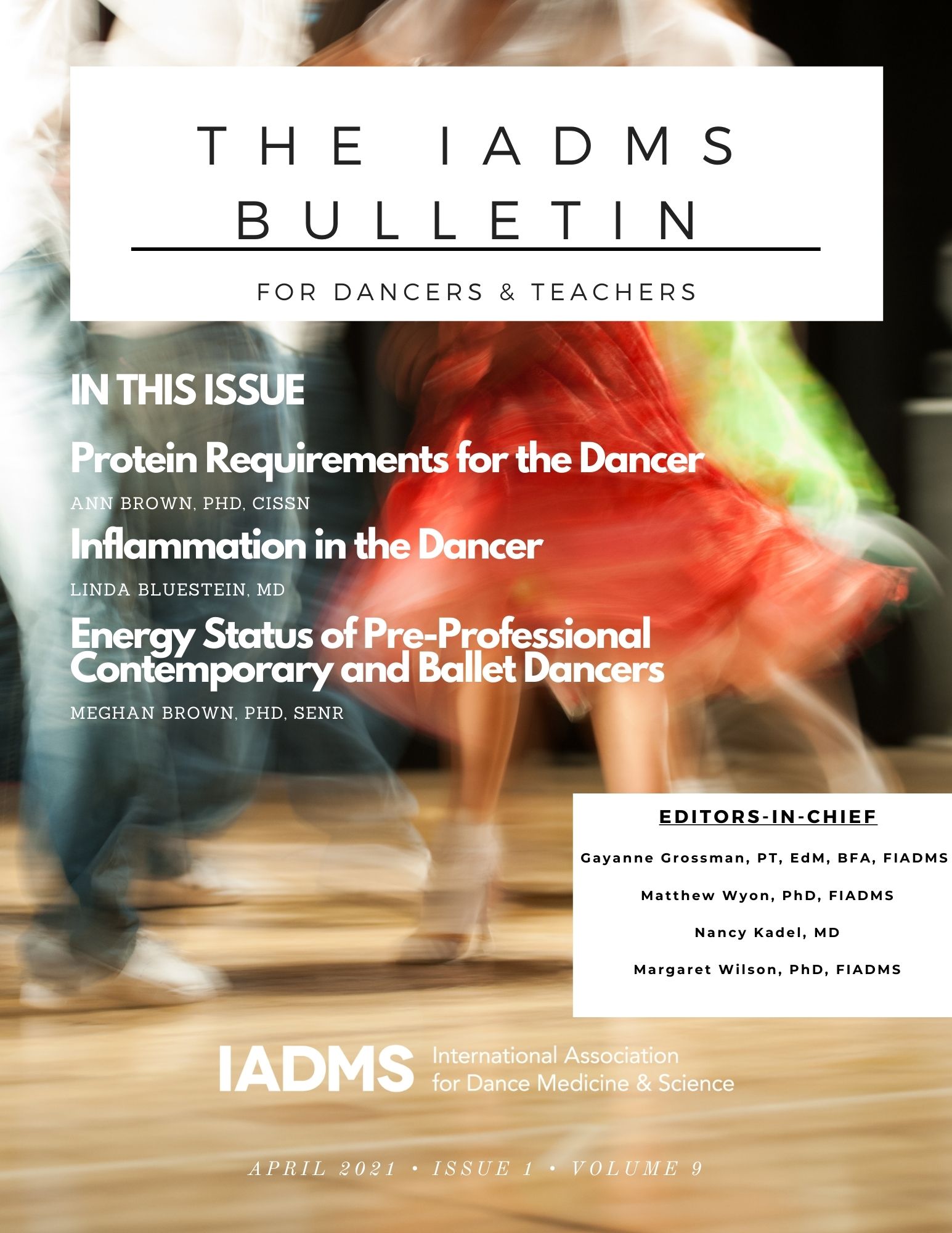The IADMS Bulletin for Dancers & Teachers
PUBLIC RESOURCE
The IADMS Bulletin for Dancers and Teachers translates peer-reviewed scientific research into accessible, practitioner-oriented articles for dancers, educators, parents, and others invested in dancer health and safety. Drawing on leading academic sources, including the Journal of Dance Medicine & Science, the Bulletin bridges the gap between research and real-world application. Each themed issue offers evidence-based strategies to support dance training and education, with a focus on injury prevention, psychological wellbeing, and performance enhancement.
The IADMS Bulletin for Dancers and Teachers is produced in partnership with the Rudolf Nureyev Foundation.


Table of Contents

Volume 9, Number 1, 2021
Protein Requirements for the Dancer. Ann Brown, Ph.D., CISSN
Inflammation in the Dancer. Linda Bluestein, MD
Energy Status of Pre-Professional Contemporary and Ballet Dancers. Meghan Brown, Ph.D., SENR
Volume 8, Number 1, 2019
Can Off-Studio Training be a Tool for Enhancing Elements of Dance Performance? Matthew Wyon, Ph.D., F.I.A.D.M.S. and Nico Kolokythas, ASCC, M.Sc.
Do Fitter Dancers Dance “Better”? The Effects of Supplementary Fitness Training in Contemporary Dance. Manuela Angioi, Ph.D.
Ballet Dancers Cardiorespiratory and Muscle Stress Responses to Classes and Rehearsals. Josianne Rodrigues-Krause, Ph.D.
Performance and Fitness Parameters Following 3-months of Aerobic and Strength-Training in Modern Dance Students. Yiannis Koutedakis, Ph.D.

Volume 7, Number 1, 2017
Turnout in Dancers: A Comprehensive Overview of Active and Passive Turnout. Gayanne Grossman, P.T., Ed.M., B.F.A., F.I.A.D.M.S.
Improving Dancer Turnout. Danielle Pata, B.F.A., Tom Welsh, Ph.D., Veoletta Range, M.F.A., Jon Bailey, Ph.D.
Can a Prescribed Turnout Conditioning Program Reduce the Differential Between Passive and Active Turnout in Pre-Professional Dancers? Astrid J. Sherman, F.I.S.T.D., Erika Mayall, M.P.T, HBSc (Kin)., Susan L. Tasker, Ph.D

Volume 6, Number 2, 2015
Back Strengthening for Dancers. Tom Welsh, Ph.D.
The Effect of Moderate Glycemic Energy Bar Consumption on Blood Glucose and Mood in Dancers. Derrick Brown, M.Sc. and Matthew Wyon, Ph.D.
Eyes-Closed Dance Training for Improving Balance of Dancers. Kimberly Hutt, M.Sc., B.Sc.(Hons)

Volume 6, Number 1, 2015
Functional Criteria for Assessing Pointe Readiness. Megan Richardson, M.S., A.T.C., Marijeanne Liederbach, Ph.D., P.T., and Emily Sandow, P.T., D.P.T
Timing Matters! Ballet Training in Soft Blocks. Alison F. Whitaker, M.Sc., B.Sc. (Hons)
Insights into the Position of the Ankle and Foot in Female Ballet Dancers En Pointe. Jeffery A. Russell, Ph.D., A.T.

Volume 5, Number 1, 2014
Fitter Dancers Dance Better: The Effects of Supplementary Fitness Training in Contemporary Dance. Manuela Angioi, Ph.D.
Pilates Technique for Improving Dancers’ Performance. Tania Amorim, M.Sc., Matthew Wyon, Ph.D.
Encouraging Dancers to Train for Upper Body Fitness. Jatin P. Ambegaonkar, Ph.D., A.T.C., O.T., C.S.C.S.

Volume 4, Number 1, 2012
Supplemental Physical Fitness Training Can Improve the Artistic Elements of Dance Performance. Matthew Wyon, Ph.D.
Body Image and Mirror Use in the Ballet Class. Sally A. Radell, M.F.A., M.A.
Supplementary Muscular Fitness Training for Dancers. Andrea Kozai, B.S., C.S.C.S.

Volume 3, Number 2, 2011
Motivational Climates: What They Are, and Why They Matter. Michelle Miulli, M.Sc., and Sanna M. NordinBates, Ph.D.
The IADMS Bulletin for Teachers Motivation Handout Dance Imagery Research: Implications for Teachers. Lynnette Young Overby, Ph.D., and Jan Dunn, M.S.
The IADMS Bulletin for Teachers Imagery Handout
Functional Anatomy in Dance Training: An Efficient Warm-Up Emphasizing the Role of the Psoas. Ruth Solomon, B.A., and John Solomon, Ph.D.

Volume 3, Number 1, 2011
Storing of Momentum in Ballet Movements. Kenneth Laws, Ph.D.
Lateral Bias in Dance Training. Marliese Kimmerle, Ph.D.
Implementing a Dance Screening Program. Karen Potter, M.F.A., Gary Galbraith, M.F.A., and Jane Baas, M.F.A.

Volume 2, Number 1, 2010
Teaching the Hypermobile Dancer. Moira McCormack, M.Sc.
Stretching for Dance. Matthew Wyon, Ph.D.
Understanding Balance: Applying Science to Dance Training. Glenna Batson, P.T., Sc.D.

Volume 1, Number 2, 2009
Standing on the Shoulders of a Young Giant: How Dance Teachers Can Benefit From Learning About Positive Psychology. Sanna M. Nordin, Ph.D. and Ashley McGill, M.Sc.
Dynamic Alignment, Performance Enhancement and the Demi-Plié. Peter Lewton-Brain, D.O., M.A.
Applying Biomechanic Research in the Dance Studio. Margaret Wilson, Ph.D.
Testing for High Intensity Dance Fitness. Emma Redding, Ph.D.

Volume 1, Number 1, 2009
Conditioning for Greater Leg Extension. Mary Virginia Wilmerding, Ph.D.
Teaching to the Whole Dancer: Synthesizing Pedagogy, Anatomy, and Psychology. Kathryn Daniels, M.A.
Improving Pelvic Alignment. Jennifer L. Deckert, M.F.A.

Disclaimer
This publication is suitable for healthcare professionals and for dance science and medicine researchers and academics. This content is not intended to be a substitute for professional medical advice, diagnosis, or treatment. Always seek the advice of your physician or other qualified health providers with any questions you may have regarding a medical condition.
IADMS owns the copyright for these Bulletins and the articles contained therein. The PDF files may be distributed or reproduced in hard (paper) copy in their entirety for educational purposes. The content may not be reproduced in any other form without the written permission of IADMS. Please contact IADMS for additional assistance.

